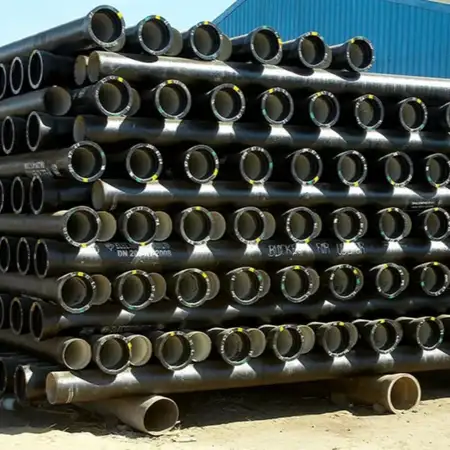Ductile iron, also known as nodular cast iron or spheroidal graphite iron, is a versatile material widely used in various industries due to its excellent mechanical properties and castability. The designation “60-45-10” refers to a specific grade of ductile iron, where the numbers represent the minimum tensile strength (in ksi), yield strength (in ksi), and elongation (in percentage), respectively. Understanding the characteristics of different ductile iron grades is crucial for selecting the appropriate material for specific applications.

1. Overview of Ductile Iron Grades
Ductile iron grades are classified based on their mechanical properties, which are influenced by their chemical composition and microstructure. The primary grades include 60-45-10, 65-45-12, and 80-55-06, each offering distinct characteristics suitable for various applications.
2. Mechanical Properties Comparison
| Grade | Tensile Strength (ksi) | Yield Strength (ksi) | Elongation (%) |
|---|---|---|---|
| 60-45-10 | 60 | 45 | 10 |
| 65-45-12 | 65 | 45 | 12 |
| 80-55-06 | 80 | 55 | 6 |
This table illustrates the differences in mechanical properties among the three grades. Higher tensile and yield strengths indicate greater load-bearing capabilities, while elongation reflects the material’s ductility.
3. Hardness Characteristics
The hardness of ductile iron grades is typically measured using the Brinell hardness test. The hardness values provide insights into the material’s resistance to indentation and wear.
-
60-45-10: Approximately 170 HB (Brinell Hardness)
-
65-45-12: Approximately 180 HB
-
80-55-06: Approximately 200 HB
These values indicate that higher-grade ductile irons offer increased hardness, enhancing wear resistance.
4. Chemical Composition
The chemical composition of ductile iron grades influences their mechanical properties and suitability for various applications.
-
60-45-10: Contains approximately 3.4% carbon, 2.8% silicon, and 0.6% manganese.
-
65-45-12: Contains approximately 3.6% carbon, 2.9% silicon, and 0.7% manganese.
-
80-55-06: Contains approximately 3.8% carbon, 3.0% silicon, and 0.8% manganese.
These compositions contribute to the differences in tensile strength, yield strength, and elongation among the grades.
5. Applications of Ductile Iron Grades
Each ductile iron grade is suited for specific applications based on its mechanical properties:
-
60-45-10: Ideal for general engineering applications, including automotive components and machinery parts.
-
65-45-12: Suitable for applications requiring higher strength and ductility, such as structural components and heavy-duty machinery.
-
80-55-06: Best for applications demanding high strength and wear resistance, like gears and crankshafts.
6. Cost Considerations
The cost of ductile iron grades varies based on their composition and manufacturing processes. Generally, higher-grade materials like 80-55-06 are more expensive due to their enhanced properties. However, the choice of material should consider the specific requirements of the application to balance performance and cost-effectiveness.
7. Heat Treatment and Microstructure
Heat treatment processes, such as annealing and quenching, can modify the microstructure of ductile iron, affecting its hardness and mechanical properties. For instance, ferritic ductile iron grades like 65-45-12 offer excellent machinability and surface finishes, while pearlitic grades like 80-55-06 provide higher strength and wear resistance.
8. Industry Standards and Specifications
Ductile iron grades are governed by various industry standards to ensure quality and consistency:
-
ASTM A536: Standard Specification for Ductile Iron Castings
-
ISO 1083: Standard for Spheroidal Graphite Cast Irons
-
DIN 1693: German Standard for Nodular Cast Iron
These standards provide guidelines for chemical composition, mechanical properties, and testing methods.
9. Future Trends in Ductile Iron Materials
Advancements in material science and manufacturing technologies are leading to the development of new ductile iron grades with improved properties. Research focuses on enhancing strength, wear resistance, and machinability to meet the evolving demands of industries such as automotive, aerospace, and heavy machinery.
10. Frequently Asked Questions (FAQs)
-
What is the difference between 60-45-10 and 65-45-12 ductile iron grades?
The primary difference lies in their mechanical properties. 65-45-12 offers higher tensile strength and elongation compared to 60-45-10, making it suitable for applications requiring greater strength and ductility.
-
Can 60-45-10 ductile iron be used for high-stress applications?
While 60-45-10 is suitable for general engineering applications, for high-stress environments, higher-grade materials like 65-45-12 or 80-55-06 are recommended due to their superior strength and wear resistance.
-
How does the chemical composition affect the properties of ductile iron?
The chemical composition, including elements like carbon, silicon, and manganese, influences the microstructure and mechanical properties of ductile iron, affecting its strength, ductility, and hardness.
-
What are the benefits of using ductile iron over other materials?
Ductile iron offers excellent castability, high strength, good wear resistance, and machinability, making it a cost-effective alternative to steel in many applications.
-
Is heat treatment necessary for ductile iron grades?
Heat treatment can enhance the properties of ductile iron grades, such as improving hardness and strength. However, the necessity depends on the specific requirements of the application.
-
What are the environmental considerations when using ductile iron?
Ductile iron is recyclable and has a lower environmental impact compared to some other materials. However, the manufacturing process should adhere to environmental standards to minimize emissions and waste.
Conclusion
Understanding the differences in mechanical properties, chemical composition, and applications of ductile iron grades 60-45-10, 65-45-12, and 80-55-06 is essential for selecting the appropriate material for specific industrial applications. By considering factors such as strength requirements, machinability, and cost, manufacturers can make informed decisions to optimize performance and efficiency.
